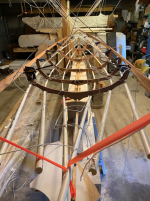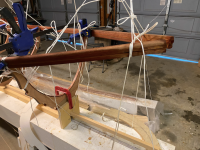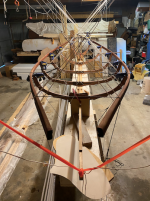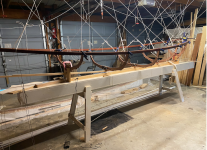Yeah, Gamma, good research on the moisture levels coming and going in the wood. With steaming though, it’s not water inside the wood, its the heat softening the Lignin glue of the tree, and letting the fibers of wood slide alongside one another. But yeah I’ve heard soaking them pre-steam helps too, and I’ve done it every other time. I like the idea of towels wrapped on assembled stringers with boiling water poured on them. There’s not as much heat applied on that method, but that might make me use it.
I got the gunnels in water using 20ft of irrigation pipe. Before hand I set seven steel posts in the ground, two of them the length of the boat apart, and five of them the separation of the frames apart. The five were set in an arced line about three to four feet away from the line of the two. Laser found the level on all the posts, marked to measure on each where the sheer arc should be. I cut seven trios of 1x3s, one about four inches, one about 12, and one 18. Then I was going to put the smallest piece of wood on the inside of the curve, the middle sized on the outside, and the 18in set vertical. There was(is) a hole at the end of each 18. That way once each assembly wes clamped together I could run a string from each hole to a post, and draw each seven assembly to the seven spots I wanted them to be. (A point about half again further from where I eventually want it to be? Trial till right…)
Gunnels were in the tube a day. The irrigation pipe needed to be sealed, I used silicone in a fancy caulk gun. Here to tell you. Lowes is great, I worked there, best job I’ve had, I still go there twice as often as I do any other store, but I didn’t buy a Lowes gun because I didn’t want a Lowes gun for life. Take the time, get the good tool, you'll love using it every time. And we'll keep those companies alive so others can still get the good tool in ten years. As said I siliconed the joints, but the middle one leaked. I used Flex Tape on the joint and it leaked. I used Gorilla tape on the joint and it stopped.
I tried to get the gunnels to soak in the irrigation pipe vertical. The whole point of this jig is so weird twists don't start. I clamped them together: I didn't want any twist to develop they weren’t both a party to. One might bend wrong but if the other bends twice as right, you might get it to work. I set one end of the piping on a sawhorse to hold it up in the air. When I slid gunnels in, they flopped 30deg to one side. Twist back to straight they hold for a moment then flop the opposite 30deg. The way weight in the water held some by gunnels wanted to set, was off at that angle.
So I pulled them back out, stacked them so the 30deg arc sent them in the direction I want them to get to, and put them back in.
That was about 24hrs ago. When I pulled them out to check on them this afternoon, they looked just how I want them to.
Well, instead of that jig, they'll just dry on the boat!
Therefore I delayed a week and a half to get a good gun, and cut the same off an estimated three week delay on the normal schedule. That being at least a week in the water and a week drying in shape.
Put them on at the same time, work side to side, so one doesn't bend the assembling frame one way or the other. I start in the middle so the gunnel stays balanced in place, then work towards the ends using same principal as massaging out bubbles under tape.
Clamped up, they fit pretty good. Right now they want to lift up the fifth frame, and they all need torsional twist at their ends. But I'm going to let them dry how they are. In a few days they might get another half day in the water, or maybe get three, but I’ll twist just the ends till we’re in agreement on how to go.
A tool to help that along is in the planning stages, I might make it just to show it even if I don’t need it like the post jig. For right now she’s not putting much strain to the frames while looking pretty good with a lot of hull rocker.
Guess that could be good for a river going rowboat.
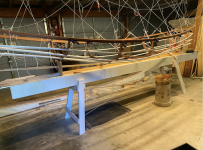
Straight so far.
